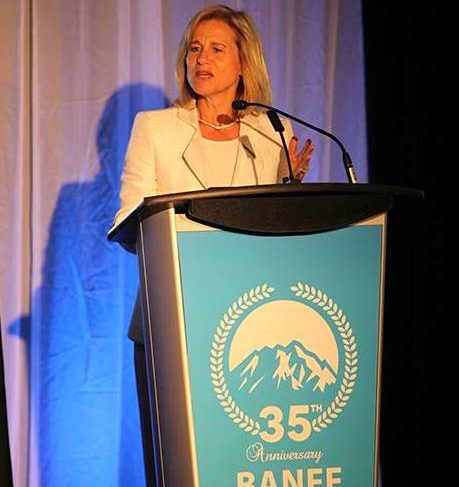
BANFF – On Sunday, seven wise folk sat as a panel to road-map what the future holds for our business.
These were: moderator Peter Sussman, executive director of Aver Media Finance (part of BMO); Jeremy Butteriss of Google Canada; Walter Levitt the CMO of Comedy Central; Kirstine Stewart the managing director of Twitter Canada; John Morayniss the CEO at EOneTV; Peter Schube the president and CEO of Jim Henson Co.; and Barbara Williams, Shaw Media's content SVP.
Let's make it clear that Williams (right) was just kidding when she exclaimed she only needed a job for three more years, so could all this digital stuff just take a pill. That was a joke folks.
But one could be forgiven for harbouring a little employment anxiety as the Millennials sound poised to kick Boomer butt.
First there's Twitter.
Okay yes, it's a 140 character place for discovery and exploration, a window to content and, as Barb says, a key part of her pre, current and post media strategies.
However, is Stewart prescient in the next big thing being "the six-second video format called Vine that's going crazy with Canadian stars"?
EOne makes it very clear that each project involves social media from the get-go, and mostly the predictable Twitter, Facebook and Instagram.
Comedy Central has gone so far as to purge the idea that it's even a channel anymore, "we're a comedy brand, looking for young guys, re-defining the business with records and tours… TV is not enough,” said Levitt.
Okay, if digital is the Next Coming why does Shaw have only 4,000 Facebook friends? (Did I see a CRTC type smirk in the audience?)
Well silly, because stars and shows have "friends" not companies and channels.
Second, then we have YouTube with five billion viewed downloads a day; and Google modestly self-defining as a simple builder of platforms for billions of users and trillions of daily connections. So let's dig a little deeper…
Today we have hyper-niche content and YouTube channels featuring video gaming with bigger money pots than The Masters Golf Tournament – and bigger screen audiences than NFL and NBA events. Indeed, there are entire dedicated YouTube channels showcasing people watching other people playing video games like Minecraft.
Alright, let's step back just for a nanosecond. It's perfectly understandable the YouTube stars are now being courted by conventional linear TV. Moreover, the role of brands on television goes back to "Westinghouse Presents" and the 1950s; that's how we've always monetized audio-visual product and we could measure it.
However, the future will be mobile. Forty percent of YouTube viewing is already on mobile devices and those viewing hours have doubled in the last 12 months.
Then there's that measurement thing. How does the future successfully and accurately count the aggregation from multiple sources, and tell a coherent and truthful story to advertisers especially in a time when many new and successful ideas will never be broadcast on traditional TV, i.e., Netflix?
Or as one panelist warned, "Amazon is the wild card, they’re going to ruin all our lives!" (I'm sure he was joking too. Or not.)
Certainly our broadcasters will research and develop more detailed ways to provide better targeted viewing data to ad buyers, they have to. But coming back to Williams…
Shaw still gets three million loyal viewers for "NCIS" on Global every Tuesday night, and that makes big money. Moreover, the top five programs on HGTV are all Canadian.
So what should we envisage from this Banff crystal-balling?
- Millennials like sharing screen stuff online. That will only increase, period.
- Five years ago we went to upfronts and locked in ad dollars with linear TV; now the trend is for advertisers to spend much more of their money online.
- These platforms are colliding. That likely means a new rights battle and legal events in Europe point in that costly direction.
- Canada needs to get its collective act together.
What seemed to make the Seattle grunge music scene so internationally successful was that those garage bands really collaborated. What seems to make the Austin (Texas) music scene so attractive to world-wide audiences is, again, a collaborative exploitation of what renders the place unique and gifted.
Maybe it's time for broadcasters and producers to play that digital tune here.
Bill Roberts is covering the Banff World Media Festival for Cartt.ca.



